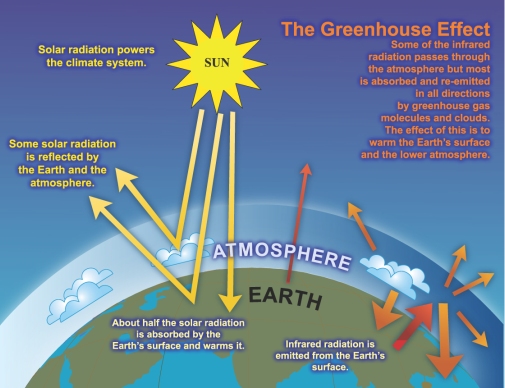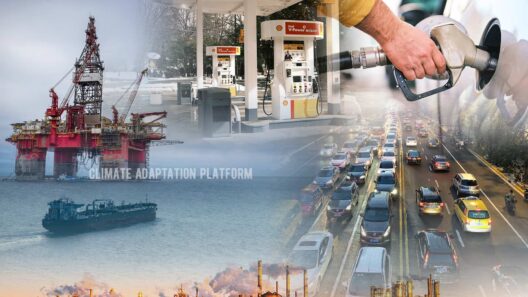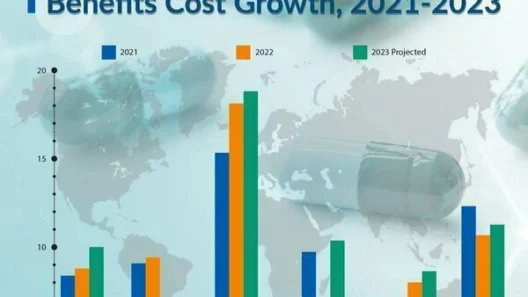The planet Earth operates within a delicate equilibrium, akin to a finely tuned clockwork mechanism. This intricate balance is profoundly influenced by the greenhouse effect, a phenomenon that is essential for sustaining life. However, in the age of industrialization and rampant fossil fuel consumption, this once-harmonious arrangement has been disrupted. The enhanced greenhouse effect has emerged as a formidable adversary in the perennial struggle against climate change. Understanding this concept is crucial as it forms the crux of contemporary debates surrounding environmental conservation and global warming.
At its core, the greenhouse effect is akin to a thermal blanket enveloping the Earth. Solar radiation filters through the atmosphere, striking the Earth’s surface and warming it. Subsequently, this energy is emitted back into the atmosphere, but not all of it escapes. Greenhouse gases—such as carbon dioxide (CO2), methane (CH4), and nitrous oxide (N2O)—trap a portion of this outgoing infrared radiation, thus preventing it from dissipating into space. This principle results in a naturally occuring process that maintains global temperatures at levels conducive to life.
However, anthropogenic activities have exacerbated this phenomenon. The exponential increase in greenhouse gas emissions, particularly over the last century, has transformed the natural greenhouse effect into an amplified version that is causing dire consequences for the planet. As more greenhouse gases accumulate in the atmosphere, they act like an insatiable sponge, absorbing heat and leading to an unprecedented rise in global temperatures. This escalation can be visualized as a pot of water gradually coming to a boil, where the heat being applied far exceeds its capacity to cool.
To comprehend the complexities of the enhanced greenhouse effect, it is vital to explore the various contributors to this climatic conundrum. The combustion of fossil fuels—coal, oil, and natural gas—remains the primary culprits. These energy sources release vast quantities of CO2 into the atmosphere, significantly outpacing the natural processes that sequester carbon. Additionally, industrial activities, deforestation, and agricultural practices compound the problem by emitting other potent greenhouse gases. Notably, methane, a gas released from livestock, landfills, and rice paddies, is more effective at trapping heat than CO2, yet its atmospheric concentration is relatively low. This fact amplifies its potential impact and emphasizes the urgency for comprehensive interventions.
Moreover, the implicit effects of human behavior cannot be overstated. Urbanization, characterized by sprawling cities and concrete jungles, replaces verdant landscapes that naturally absorb CO2. The loss of forests not only diminishes the Earth’s ability to act as a carbon sink but also disrupts biological habitats, further exacerbating biodiversity loss. The intricate interplay between climate change and ecological degradation illustrates the multifaceted nature of the issues at hand.
In contemplating solutions to counteract the enhanced greenhouse effect, it is crucial to engage with both mitigation and adaptation strategies. Mitigation focuses on reducing or preventing the release of greenhouse gases, while adaptation emphasizes adjusting to the changes that are already occurring. The integration of renewable energy sources—such as solar, wind, and hydroelectric power—into the energy grid presents a promising avenue for reducing reliance on fossil fuels. Transitioning to these cleaner alternatives not only lessens emissions but also fosters sustainable development, a concept that prioritizes long-term ecological balance over short-term economic gain.
Additionally, reforestation efforts can play a pivotal role in combating climate change. Planting trees sequesters carbon, restores habitats, and promotes biodiversity. By investing in nature-based solutions, society harnesses the restorative power of ecosystems while also addressing the socio-economic challenges of impoverished communities that rely heavily on natural resources.
Adaptation, on the other hand, requires a shift in mindset. As climate impacts become increasingly severe—from more frequent and intense storms to prolonged droughts—societies must develop resilience. This encompasses creating infrastructure capable of withstanding extreme weather and implementing water management strategies in anticipation of changing precipitation patterns. Acknowledging the interconnectedness of systems is paramount; for instance, sustainable agriculture practices can mitigate emissions while enhancing food security in an era of uncertainty.
Education and advocacy are equally crucial in the battle against the enhanced greenhouse effect. By raising awareness about the implications of climate change and the importance of sustainable practices, individuals can become agents of change. Grassroots movements, political engagement, and scientific literacy empower communities to demand accountability from leaders and industries alike. The narrative surrounding climate action must shift from alarmism to empowerment, illustrating that collective action can yield tangible results. This engagement can foster a new social contract wherein sustainability and responsibility become ingrained in societal norms.
The equation of climate change is multifaceted and complex, and decoding it necessitates a concerted effort from all sectors of society. The enhanced greenhouse effect serves as both a grave warning and a call to action. Tackling this intricate issue requires an unwavering commitment to innovation, sustainable practices, and real change. Just as the Earth’s climate is interwoven with innumerable strands of ecological, social, and economic threads, so too must our approach to mitigating its challenges resonate across the spectrum of human endeavor. Embracing this challenge with tenacity can ultimately lead to a more sustainable future, where the balance of our planet is restored, and the clockwork of life continues to tick harmoniously in tune with the cosmos.








